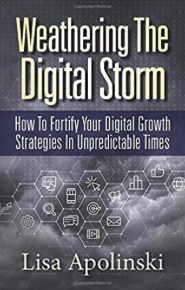PHOENIX, Aug. 13, 2019 /PRNewswire/ — A wise business today guards its digital assets like the United States guards the gold in Fort Knox.
“A business needs to be agile with digital growth strategies and data points if it wants to succeed today, and it needs to guard its digital assets in a digital fortress,” says author Lisa Apolinski, author of the book Weathering the Digital Storm: How to Fortify Your Digital Growth Strategies in Unpredictable Times (2019, www.indiebooksintl.com).

“Just because you can do many cool things with digital growth strategies doesn’t mean you should,” says Apolinski. “The internet is the greatest and most efficient time-waster ever invented by humankind, and there are also digital dangers lurking for the unwary business.”
Over six years ago, Apolinski quit the corporate grind to form her own digital marketing consulting agency. Apolinski is the founder and CEO of 3 Dog Write Inc., a full- service digital consulting agency. 3 Dog Write provides strategic consulting around digital engagement and creation and proper use of digital assets.
“Digital marketing is like a climb with no summit,” says Apolinski. “But this climb, while continuous and difficult at times, can bring insight, growth, and strength to your organization.”
Apolinski specializes in digital growth strategies, which includes promotional outreach using digital technologies, mainly through the internet, but also including mobile phones and any other digital media.
She warns there are great risks with digital business. Here are steps Apolinski advises organizations take for understanding data points and making data application work:
1. Understand your data points. What do data points mean and what do they not mean for digital engagement? What significance do executives or other individuals put on select data points?
2. Put data into context. This can be the hardest point to master. A data point without context is simply a number. Look at the how to understand the why.
3. Dig deeper into your data. One data point should never dictate strategy (as the cautionary tale above illustrates). A deeper picture of digital engagement can be found when additional data is added to the story.
4. Get into the habit of reporting. Get into the habit of looking at data in reports. A good rule of thumb is to pull weekly reports and set up comparisons (week over week, year over year) so data can be tracked easily and trends can be seen early.
5. Compare the data. Benchmark comparison to other industry competitors can help an organization to not fall into the trap of falling in love with their own data. Comparisons can also help with understanding digital channel metrics and what is considered an average or above-average metric mark.
6. Take control. The best thing an organization can do is to take control and understand its own data. No one will understand an organization’s data better than the organization—including industry nuances and changes in the economic environment that affects digital engagement.
Apolinski is an international speaker, author, and digital strategist. She is considered a digital engagement thought leader and has worked in the industry for more than two decades. Her focus is on the end-user experience, whether it be the venue, technology, or communication.
About Indie Books International
Indie Books International (www.indiebooksintl.com) was founded in 2014 in Oceanside, California by two best-selling business authors. Since then the company has released more than 100 titles. Similar to indie film companies and indie music labels, the mission of Indie Books International is to serve as an independent publishing alternative for business thought leaders.
Contact
Henry DeVries
[email protected]
619-540-3031
SOURCE Indie Books International
